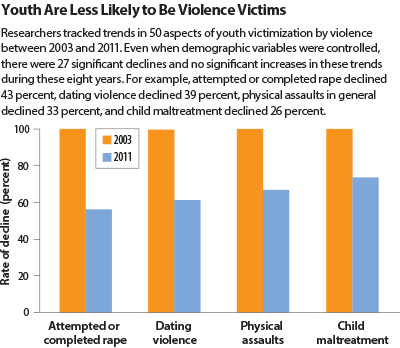Even though shootings at schools, theaters, or malls dominate the news, it looks as if violence directed against America’s youth is on a downward trajectory.
This is a key finding from a study conducted by David Finkelhor, Ph.D., director of the Crimes Against Children Research Center at the University of New Hampshire, and colleagues. The results were published April 28 in JAMA Pediatrics.
The study was based on three national telephone surveys of representative samples of children and adolescents and their caregivers from 2003, 2008, and 2011. Each survey concerned children’s victimization by violence.
During each of the three surveys, a short interview was conducted with an adult caregiver (usually a parent) to obtain demographic information. The youngster in the household with the most recent birthday was selected for an interview. If the selected child or adolescent was aged 10 to 17, the interview was conducted with the child. If the child was younger than age 10, the interview was conducted with the caregiver.
Survey results from nearly 1,100 youth were analyzed.
The researchers used the survey results to track trends in 50 aspects of youth victimization by violence from 2003 to 2011—for example, a physical assault with no weapon or injury, an assault by a peer or sibling, property victimization, sexual assault by a known adult, attempted or completed rape, bullying, or dating violence. Even when demographic variables were controlled, there were 27 significant declines and no significant increases in these trends during the eight years.
For example, attempted or completed rape declined 43 percent, dating violence declined 39 percent, physical assaults in general declined 33 percent, and child maltreatment declined 26 percent.
The major recession that started in 2008 did not appear to reverse the downward trends, although there were fewer significant declines during the 2008 to 2011 period than during the six preceding years. “This suggests that although the recession may have caused much hardship, it did not translate into more violence and crime exposure for children and youth,” the researchers said.
The researchers suggested several factors that may account for the decline in violence. One might be the growth and dissemination of prevention and intervention strategies aimed at reducing violence against youth—for instance, school-based prevention programs targeting bullying, interpersonal conflict, and sexual and dating violence, some of which have been found effective in rigorous evaluation studies.
“There is no single more preventable and important cause of psychiatric harm to children than exposure to violence,” Andrew Gerber, M.D., Ph.D., an assistant professor of psychiatry at Columbia University and a child and adolescent psychiatrist, told Psychiatric News. “It is enormously encouraging to learn that the concerted effort over the past two decades to minimize this exposure appears to be paying off in the form of reduced exposure to violence in our nation’s children. While no study can ever demonstrate conclusively that national policies are responsible for this effect, this study suggests strongly that exposure is decreasing and that informed policies are at least partially responsible for this improvement.”
The research was funded by multiple sources, including the Centers for Disease Control and Prevention and the Office of Juvenile Justice and Delinquency Prevention. ■
An abstract of “Trends in Children’s Exposure to Violence, 2003 to 2011” can be accessed
here.

